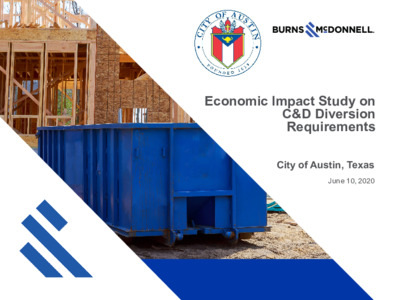2b. Economic Impact Study on Construction and Demolition Diversion Requirements Presentation — original pdf
Backup

Economic Impact Study on C&D Diversion Requirements City of Austin, Texas June 10, 2020 Agenda Goals & Objectives Outreach and Data Analysis Overview Economic Impacts of C&D Diversion Reuse Markets C&D Debris Markets Key Findings & Recommendations 2 Goals & Objectives ► Evaluate economic impact of the ordinance on household affordability ► Assess capacity of local reuse markets ► Assess material markets and processing capacity for additional C&D recycling ► Evaluate whether City should implement next diversion milestone per C&D Ordinance 3 Outreach and Data Analysis Overview Outreach ► Interviewed C&D-Related Entities: City departments, haulers, processors, associations, Non-government organizations (NGOs) Data Analysis ► Analyzed City provided data (ARR, AEGB, DSD) ► Quantify cost per square foot by project sector for disposal and diversion 4 Diversion Performance Under C&D Ordinance and AEGB Based on Available Data Diversion Percentage 75% Diversion Requirement 50% Diversion Requirement 90% 80% 70% 60% 50% 40% 30% 20% 10% 0% Single Family Multi-Family Non-Residential C&D Ordinance Diversion AEGB Diversion ► Note: Austin Energy Green Building Program does not track diversion of single-family projects and all projects are completed voluntarily. 5 Challenges to Justify Increased Diversion Requirements ► C&D Ordinance data reports indicate projects are capable of meeting higher diversion levels ► Low reporting rate may skew diversion performance upward, and therefore reported numbers may not be representative of all projects ► Challenges to justify increased diversion requirements • Number of reporting projects decreased from 163 to 73 between 2018 and 2019 • Demolition projects have only had to comply since October 1, 2019 ► ARR staff currently (1) developing enforcement program under C&D Ordinance to increase reporting rate going forward and (2) planning to analyze demolition project data to inform decision-making 6 Minimal Economic Impact to Household Affordability Net Cost Impact of Increasing from 50% to 75% Diversion t o o F e r a u q S r e p t c a p m I t s o C t e N $0.035 $0.030 $0.025 $0.020 $0.015 $0.010 $0.005 $0.000 0.035% 0.030% 0.025% 0.020% 0.015% 0.010% 0.005% 0.000% t s o C l a t o T f o t n e c r e P s a t c a p m I Single Family Multi-Family Non-Residential 7 Small Number of Relocation and Deconstruction Projects ► Material targeted for reuse include: • Windows, doors, cabinets, light fixtures, metal roofing, unused tile, cabinets, counters, toilets, sinks, antique bricks ► Limited number of relocation or soft-strip projects conducted annually projects ► The ReUse People have completed 25 soft-strips and 28 relocation projects since 2015 • Soft strips projects typically yield three to seven tons of material • Focus is on single-family homes – few covered under C&D Ordinance ► Private contractors complete a limited number of deconstruction • Detailed data on private contractor's deconstruction projects is unavailable 8 Limited Reuse Outlets in City ► Habitat for Humanity ReStore only outlet identified for reuse of deconstruction material ► Current capacity sufficient to handle increased volume associated with C&D Ordinance diversion requirements ► May reach capacity limits if deconstruction projects increase on City-wide basis 9 Encourage Deconstruction Projects ► Deconstruction currently focused on single-family projects ► Consider voluntary incentives for commercial and multi-family • Weight reuse material higher toward diversion requirements under C&D projects, as appropriate: Ordinance • Provide rebate of permitting fees • Establish tax incentives based on volume or value of salvaged material 1 0 Demand for Construction & Demolition Materials Material Construction Demolition Local End-Market Demand Concrete/Aggregate Cardboard Metal Plastic Untreated Lumber Gypsum (Drywall) Shingles High High High High Medium Medium Low ► Markets for individual materials determine extent processors can separate and divert ► Demolition presents additional challenges for recovering uncontaminated recyclable material 1 1 Challenges Associated with Material Handling ► Processors require recycling loads with consistently low contamination ► Job sites may not be large enough to place and service dedicated co-mingled recycling roll-offs ► City can provide technical assistance, education and outreach related to best practices on configuring job sites and reducing contamination 1 2 Limited Processing Capacity Available to Third-Party Haulers ► Market constraints due to limited processing facilities for third- party haulers ► Four of 58 active C&D haulers own/operate processing capacity for co-mingled C&D recycling ► One qualified processor available – accepts limited third-party material ► Third-party haulers struggle to compete with haulers that own or contract with processing facilities on projects that must comply with the C&D Ordinance ► Consider opportunities to support haulers that do not own processing or disposal facilities to recycle C&D debris as part of ongoing Zero Waste Master Plan update 1 3 Key Findings 1. Minimal economic impact to household affordability associated with increased diversion requirements 2. Demolition projects have only been part of the C&D Ordinance requirement since October 1, 2019 3. There has not been sufficient time to collect data from demolition projects 4. Low percentage of projects reporting under C&D Ordinance may skew diversion performance upward 5. Processors able to handle increased volume if key materials are not contaminated 6. Third party haulers struggle to compete on C&D Ordinance projects or AEGB projects because limited processing facility access available 1 4 Recommendations 1. Delay decision on increasing from 50 to 75 percent diversion - consider phased approach with increased enforcement and third-party verification 2. Analyze submissions from demolition projects to identify if they should be treated the same as new construction 3. Increase resources dedicated to enforcement under C&D Ordinance to increase reporting rate 4. Support generators to reduce contamination of co-mingled recycling loads through technical assistance, education and outreach 5. Consider opportunities to support haulers that do not own processing or disposal facilities to recycle C&D debris as part of ongoing Zero Waste Master Plan update 1 5 Questions? 1 6